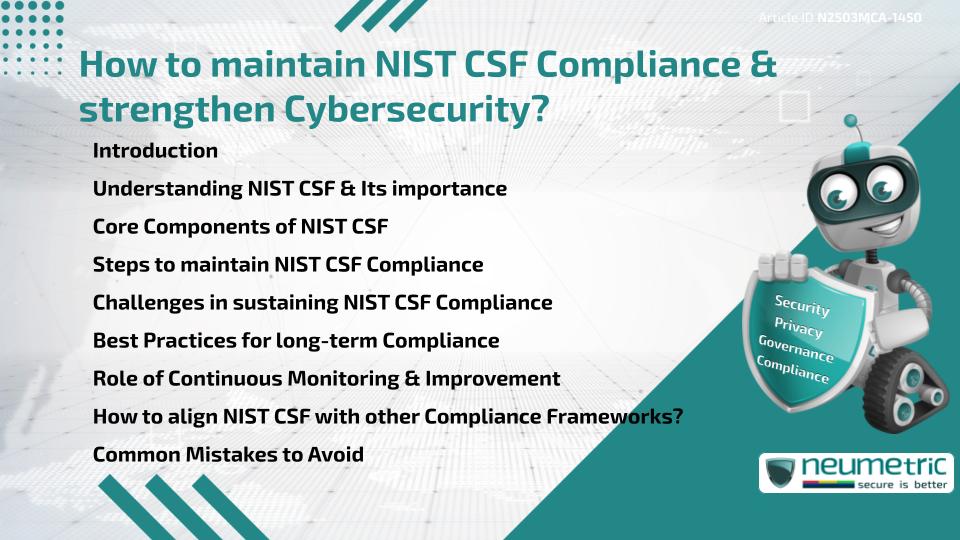Table of Contents
ToggleIntroduction
The National Institute of Standards & Technology Cybersecurity Framework [NIST CSF] provides a very structured approach for managing Cybersecurity Risks. Organisations aiming for NIST CSF Compliance must adopt its core functions—Identify, Protect, Detect, Respond & Recover. However, maintaining compliance is an ongoing effort that requires continuous evaluation & adaptation. This article explores how to maintain NIST CSF Compliance effectively while addressing common challenges & best practices.
Understanding NIST CSF & Its importance
NIST CSF was introduced in 2014 to help Organisations enhance their Cybersecurity Posture. Unlike rigid Regulatory Frameworks, it is flexible & adaptable across Industries. Compliance with NIST CSF helps Businesses:
- Strengthen Cybersecurity Defenses
- Reduce Risks of Cyber Threats
- Align with Industry Best Practices
- Improve Regulatory Standing
Core Components of NIST CSF
The framework consists of three main components:
- Core Functions: Identify, Protect, Detect, Respond & Recover.
- Implementation Tiers: Levels of Risk Management maturity, ranging from Partial (Tier 1) to Adaptive (Tier 4).
- Profiles: Customisation of CSF to align with an Organisation’s specific needs.
Steps to maintain NIST CSF Compliance
Conduct Regular Risk Assessments
Frequent Risk Assessments help identify Vulnerabilities & assess changes in the Threat Landscape.
Update Cybersecurity Policies
Policies should evolve to reflect emerging Risks & changes in Technology.
Implement Continuous Monitoring
Using Security Information & Event Management [SIEM] Tools & Automated Alerts helps detect & respond to Threats in real time.
Train Employees on Cybersecurity
Staff Awareness & Training reduce risks related to Phishing, Social Engineering & Human Errors.
Review & Test Incident Response Plans
Simulated Cyber Attack Exercises ensure preparedness & resilience.
Challenges in sustaining NIST CSF Compliance
Resource Constraints
Small & Medium-sized Businesses [SMBs] often struggle with the cost of implementing NIST CSF.
Evolving Cyber Threats
Cyber Threats constantly change, requiring continuous adaptation of Security Measures.
Integration with Existing Frameworks
Organisations following ISO 27001 or SOC 2 may find overlapping Controls & Compliance redundancies.
Best Practices for long-term Compliance
- Align Compliance efforts with Business Objectives.
- Automate Compliance Tracking where possible.
- Regularly audit Cybersecurity Measures.
- Foster a cybersecurity culture within the Organisation.
Role of Continuous Monitoring & Improvement
Ongoing Compliance requires:
- Real-time monitoring of Security Events.
- Periodic evaluation of Security Controls.
- Adapting Policies to new Threats & Compliance updates.
How to align NIST CSF with other Compliance Frameworks?
NIST CSF & ISO 27001
ISO 27001 focuses on an Information Security Management System [ISMS], while NIST CSF is Risk-based. Both can complement each other in strengthening Cybersecurity.
NIST CSF & SOC 2
SOC 2 ensures secure Data Handling & NIST CSF supports it by enhancing Cybersecurity Controls.
Common Mistakes to Avoid
- Relying on outdated Security Policies.
- Overlooking Employee Training.
- Ignoring periodic Compliance Audits.
- Not aligning NIST CSF with existing security strategies.
Conclusion
Maintaining NIST CSF compliance is an ongoing process that requires a proactive approach to Risk Management, regular updates to Cybersecurity policies & continuous Employee Training. By integrating Compliance efforts with Business Objectives & leveraging Automation, Organisations can effectively manage Security Risks. Regular Monitoring, Audits & alignment with other Security Frameworks further enhance long-term Compliance. Ultimately, a well-maintained NIST CSF Program strengthens an Organisation’s overall Cybersecurity Resilience.
Takeaways
- How to maintain NIST CSF Compliance requires continuous Risk Assessments & Policy Updates.
- Training Employees on Cybersecurity strengthens Compliance efforts.
- Integrating Compliance with other Security Frameworks can improve efficiency.
- Continuous Monitoring ensures adaptability against evolving Cyber Threats.
FAQ
What is the purpose of NIST CSF?
NIST CSF helps Organisations manage & reduce Cybersecurity Risks using a structured approach based on core functions.
How often should an Organisation review NIST CSF Compliance?
Regular Reviews, ideally Annually or after significant changes in the Cybersecurity Landscape, help maintain Compliance.
Can Small Businesses implement NIST CSF?
Yes, NIST CSF is scalable & adaptable, making it suitable for Organisations of all sizes.
How does NIST CSF Compliance benefit an Organisation?
It improves Cybersecurity Posture, reduces Risk Exposure & aligns with Industry Standards for Regulatory Compliance.
Does NIST CSF replace other Compliance Frameworks?
No, it complements Frameworks like ISO 27001 & SOC 2, enhancing overall Security Measures.
Is NIST CSF Compliance mandatory?
No, but many Industries adopt it voluntarily to strengthen Cybersecurity Practices.
What are Common Challenges in maintaining NIST CSF Compliance?
Challenges include Resource Constraints, evolving Threats & integrating it with other Compliance Frameworks.
How can Organisations ensure long-term NIST CSF Compliance?
Continuous Monitoring, Employee Training & Regular Risk Assessments help sustain Compliance.
Does NIST CSF apply to Cloud Security?
Yes, Organisations can adapt NIST CSF principles to strengthen Cloud Security Measures.
Need help?
Neumetric provides organisations the necessary help to achieve their Cybersecurity, Compliance, Governance, Privacy, Certifications & Pentesting goals.
Organisations & Businesses, specifically those which provide SaaS & AI Solutions, usually need a Cybersecurity Partner for meeting & maintaining the ongoing Security & Privacy needs & requirements of their Clients & Customers.
SOC 2, ISO 27001, NIST, HIPAA, HECVAT, EU GDPR are some of the Frameworks that are served by Fusion – a centralised, automated, AI-enabled SaaS Solution provided by Neumetric.
Reach out to us!




